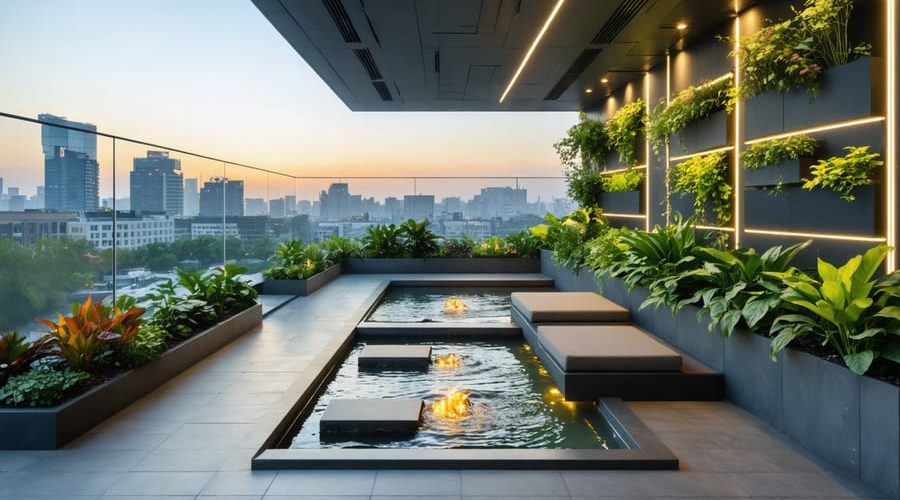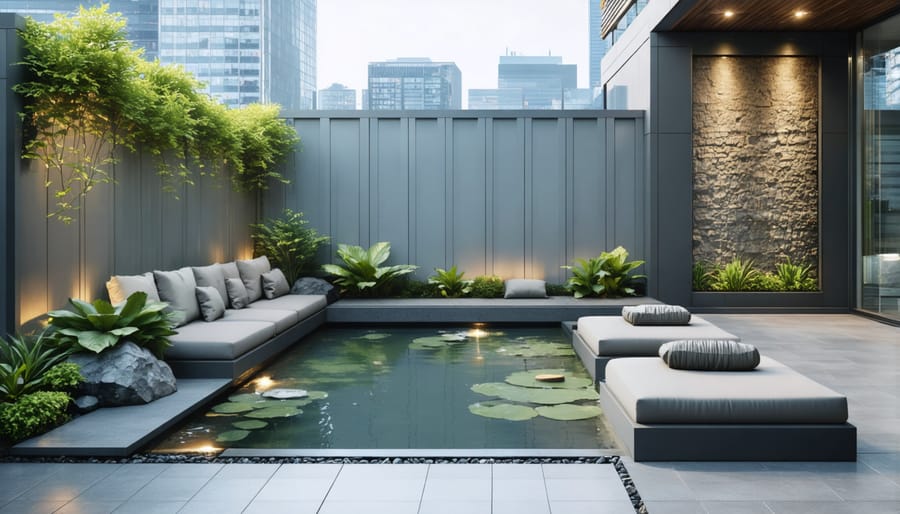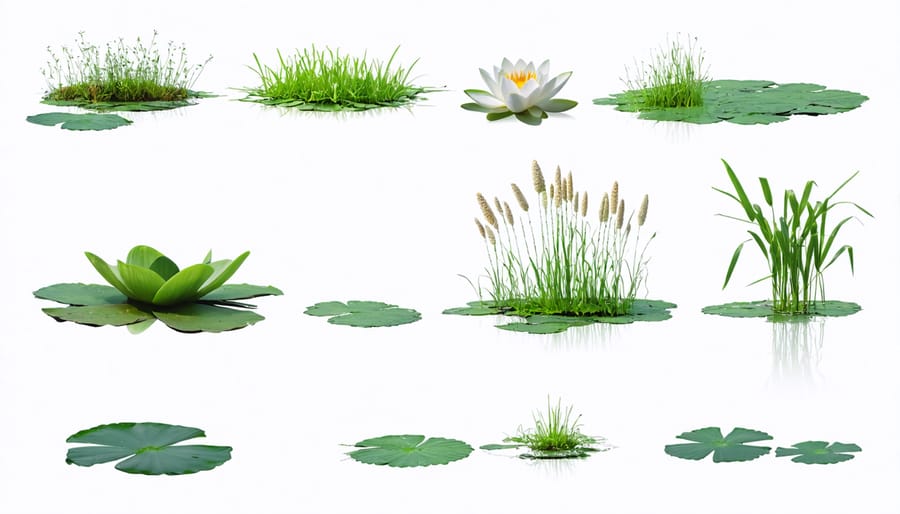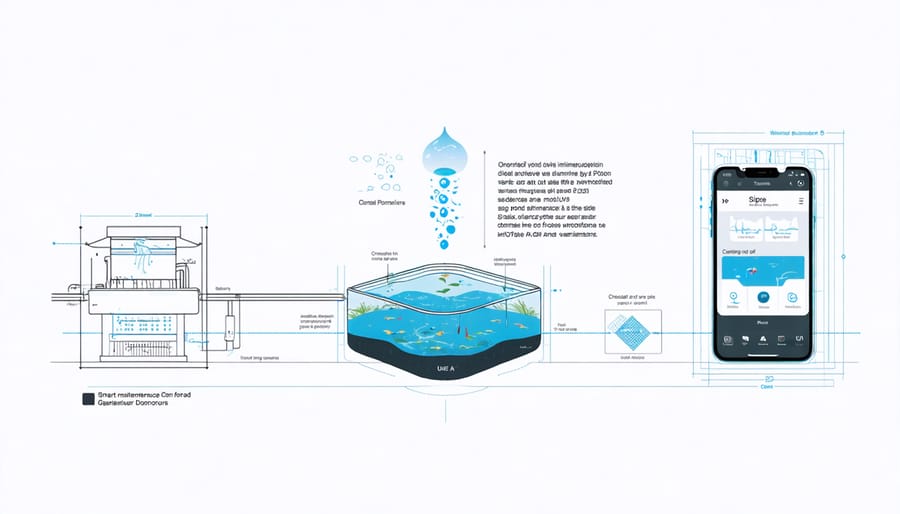
Transform Your City Space with a Stunning Urban Pond
Transform your urban space into a thriving aquatic oasis, where concrete meets nature in perfect harmony. Urban ponds represent more than just water features; they’re living ecosystems that bring wildlife, tranquility, and natural beauty to city landscapes. Whether you’re working with a compact backyard or a modest patio, these adaptive water gardens prove that size doesn’t limit the potential for creating stunning aquatic environments.
In today’s fast-paced urban environments, where green spaces are increasingly precious, urban ponds serve as vital sanctuaries for both humans and local wildlife. They offer a practical solution for city dwellers seeking to incorporate sustainable water features into their limited outdoor spaces while providing essential habitat for birds, beneficial insects, and aquatic life. From sleek modern designs that complement contemporary architecture to naturalistic installations that mirror woodland pools, urban ponds demonstrate how thoughtful design can maximize the impact of even the smallest water features.
As we explore the art of urban pond creation, you’ll discover how to overcome common city challenges while crafting a sustainable, low-maintenance water feature that enhances your outdoor living space and contributes to urban biodiversity.
Smart Design Solutions for Limited Space
Vertical Integration
Vertical integration offers an innovative solution for urban pond enthusiasts working with limited space. By utilizing walls and vertical surfaces, you can create stunning water features that maximize your available area while adding a dramatic visual element to your outdoor space.
Consider installing wall-mounted fountains or cascading water walls that can transform plain surfaces into eye-catching aquatic displays. These features not only save ground space but also create soothing water sounds that help mask urban noise. Tiered planters with small water pools can be arranged vertically, combining both greenery and water elements in a space-efficient design.
Living walls integrated with water features are particularly effective, allowing you to create a lush, garden-like atmosphere even in tight spaces. Try incorporating pocket planters with trailing water-loving plants alongside your vertical water feature. For a modern touch, consider sleek panel fountains that can be mounted flush against walls or fences.
Remember to ensure proper waterproofing and structural support when installing vertical water features. Most vertical systems can be connected to a hidden reservoir at the base, making maintenance relatively straightforward while keeping the aesthetic clean and uncluttered.
Container and Raised Pond Options
Living in an urban environment doesn’t mean you have to give up on your dream of having a pond. Container and raised pond options offer excellent small space water features that can transform any outdoor area into a tranquil oasis.
For balconies and patios, consider using large ceramic pots, wooden half-barrels, or specially designed pond containers. These portable options are perfect for urban dwellers as they’re lightweight, easy to maintain, and can be moved if needed. A container pond as small as 2 feet in diameter can support a few aquatic plants and even a couple of small fish.
Raised ponds are another fantastic solution for small yards or areas where digging isn’t possible. You can build them using materials like brick, stone, or wooden sleepers, creating a feature that doubles as seating or a garden border. The elevated design makes maintenance easier on your back and creates an eye-catching focal point in your outdoor space.
When planning your container or raised pond, remember to:
– Choose containers with adequate depth (at least 18 inches for fish)
– Ensure proper waterproofing
– Install a small pump for water circulation
– Select appropriately sized plants
– Position in a spot that receives 4-6 hours of sunlight
– Include a shallow shelf for marginal plants
These space-saving solutions prove that you don’t need a large garden to enjoy the peaceful ambiance of moving water and aquatic life. With proper planning, even the smallest urban spaces can accommodate a thriving water feature that brings nature closer to home.

Urban-Friendly Plant Selection
Low-Maintenance Aquatic Plants
When it comes to urban ponds, choosing the right plants can make maintenance a breeze. Water lilies are perfect for small spaces, providing beautiful blooms while helping to keep the water clear. These hardy plants come in dwarf varieties that won’t overwhelm your pond and require minimal care beyond occasional deadheading.
Another excellent choice is the marsh marigold, which brings cheerful yellow flowers in spring and thrives in both shallow water and boggy areas. For natural filtration, consider hornwort, a submerged plant that helps maintain water quality and provides shelter for pond life.
Japanese rush is particularly well-suited to urban environments, as it’s resistant to pollution and can handle fluctuating water levels. Its vertical growth makes it perfect for tight spaces, while its year-round greenery adds constant visual interest.
Don’t overlook the versatile water iris, which not only adds architectural interest with its sword-like leaves but also helps remove excess nutrients from the water. For surface coverage, duckweed is a fantastic option that requires virtually no maintenance and helps shade the water, reducing algae growth.
These plants are not just decorative – they work together to create a self-sustaining ecosystem that needs minimal intervention, perfect for busy city gardeners.

Seasonal Considerations
Urban ponds require different care approaches throughout the year to maintain their beauty and health. In spring, focus on removing debris that accumulated over winter and trimming back any dead plant material. This is also the perfect time to divide and replant marginal plants that have become overcrowded.
Summer brings rapid plant growth and potentially problematic algae blooms. Regular maintenance of water plants is crucial – remove yellowing leaves and deadhead flowers to keep the pond looking fresh. Consider adding floating plants like water lilies to provide shade, which helps control water temperature and algae growth.
Fall demands attention to falling leaves, which can overwhelm urban ponds quickly. Install a pond net early in the season to catch leaves before they sink. This is also the time to cut back marginal plants and prepare tropical species for winter storage.
Winter care in urban settings focuses on protecting your pond’s ecosystem. If you’re keeping the pond running, maintain a small opening in the ice for gas exchange. Remove any snow accumulation from ice surfaces to allow light penetration for underwater plants. In regions with harsh winters, consider using a pond heater to prevent complete freezing.
City-Specific Considerations
Local Regulations and Permits
Before starting your urban pond project, it’s essential to check your local regulations and obtain necessary permits. Most cities have specific rules about water features, particularly regarding depth, safety barriers, and water usage. Contact your local planning department or visit their website to learn about zoning requirements and any restrictions that might affect your pond design.
Many municipalities require permits for water features exceeding certain dimensions or those involving electrical installations for pumps and lighting. You’ll also need to check if there are any utility lines underground before digging – this typically involves calling your local utility marking service.
Some areas have water conservation laws that might impact your pond’s size or filling schedule. Additionally, if you’re part of a homeowners association (HOA), review their guidelines as they may have specific requirements about outdoor modifications.
Safety regulations often mandate fencing around deeper ponds, especially in areas with children. Insurance considerations are also important – contact your homeowner’s insurance provider to understand how a pond might affect your coverage and what safety measures they recommend.
Remember to keep copies of all permits and approvals for future reference. This documentation can be valuable when maintaining or modifying your pond later.
Safety and Access
Safety should be your top priority when maintaining an urban pond, especially in areas with children and pets. Install secure fencing at least 4 feet high around the pond, with a self-closing, lockable gate to prevent unauthorized access. Consider adding a pond safety grid just below the water surface – these invisible mesh systems protect against accidental falls while preserving the pond’s natural appearance.
Good lighting is essential not just for aesthetics but safety too. Place weatherproof LED lights around pathways and strategic points to illuminate the area during evening hours. Install non-slip materials on walking surfaces near the pond to prevent accidents, especially important during wet weather.
If your pond is deeper than 2 feet, post clear safety signs indicating water depth and basic rules. Keep rescue equipment like a life ring or reaching pole easily accessible. Regular maintenance of surrounding areas is crucial – trim vegetation to maintain clear sightlines and remove any tripping hazards.
For public urban ponds, coordinate with local authorities to ensure compliance with safety regulations and consider installing emergency call boxes nearby.
Noise and Light Considerations
Living in an urban environment means dealing with various sources of noise and light pollution that can affect your pond’s ecosystem. Traffic sounds, construction work, and city lights can impact both wildlife and your enjoyment of the water feature. To minimize noise disturbance, consider incorporating natural sound barriers like decorative bamboo screens or strategically placed rocks that help deflect unwanted noise.
Water features like small waterfalls or fountains can create pleasant white noise that masks urban sounds while adding visual interest to your pond. Just remember to adjust water flow during evening hours to maintain neighborly relations.
For nighttime considerations, be mindful of artificial light sources that might disturb aquatic life. While you’ll want to illuminate your pond for safety and aesthetics, opt for gentle pond lighting solutions that create ambiance without overwhelming the space. Use shielded lights directed downward and consider motion sensors or timers to reduce unnecessary illumination.
Creating a balance between urban living and natural tranquility is key. By thoughtfully managing these environmental factors, your urban pond can become a peaceful retreat from city life.
Maintenance Made Easy
Automated Systems
Modern technology has revolutionized urban pond maintenance, making it easier than ever to keep your water feature healthy and beautiful. Automated systems can handle many routine tasks, giving you more time to enjoy your pond rather than maintain it.
The heart of any automated system starts with quality filters for urban ponds, which can be programmed to run on schedules that match your pond’s specific needs. Smart pumps now come with mobile apps that let you control water flow and monitor energy usage right from your smartphone.
Automatic feeders are a game-changer for fish owners, dispensing precise amounts of food at set times, perfect for busy urban lifestyles. LED lighting systems can be programmed to create beautiful displays at night, with options to change colors and intensity based on the time of day or special occasions.
Water level monitors help maintain consistent depths by automatically topping up the pond when levels drop, while smart thermometers alert you to temperature changes that might affect your aquatic life. UV clarifiers can switch on during peak sunlight hours to combat algae growth, and automated skimmers keep surface water clear of debris.
For those who travel frequently, complete monitoring systems can send alerts to your phone about water quality, pump operation, and filter status, ensuring peace of mind while you’re away from home.

Quick Maintenance Routines
Keeping your urban pond in top shape doesn’t have to be time-consuming. With these quick maintenance routines, you can enjoy a healthy water feature without spending hours on upkeep. The key to maintaining water features is consistency rather than lengthy cleaning sessions.
Start with a weekly 15-minute check of your pond’s water level and top it off as needed. During this quick inspection, remove any floating debris with a net – this prevents organic matter from decomposing and affecting water quality. Keep a small net handy near your pond for easy access.
Monthly tasks should include checking your pump and filter system. Simply listen for unusual sounds and ensure water flow is consistent. Clean your filter media with pond water, not tap water, to preserve beneficial bacteria. Trim any overhanging plants to prevent excess leaves from falling in.
Seasonal maintenance can be accomplished in under an hour. In spring, remove winter debris and check equipment. Summer requires occasional algae monitoring and removal. Fall calls for installing nets to catch leaves, while winter needs periodic ice-free spots for gas exchange.
Pro tip: Keep a maintenance calendar on your phone with reminders for these quick tasks. This prevents small issues from becoming big problems and helps maintain your pond’s beauty with minimal effort.
Remember to observe your pond during these quick checks – you’ll start noticing patterns and can address potential problems before they develop, saving time and effort in the long run.
Creating an urban pond is more than just adding a water feature to your outdoor space – it’s about bringing a slice of nature into the heart of the city. As we’ve explored throughout this guide, urban ponds offer numerous benefits, from supporting local wildlife to creating a peaceful retreat right in your backyard.
Remember that successful urban pond projects start with careful planning. Consider your available space, local regulations, and maintenance requirements before breaking ground. Whether you’re working with a tiny courtyard or a modest backyard, there’s always room for a water feature that fits your lifestyle and environment.
The key to a thriving urban pond lies in striking the right balance between aesthetics and functionality. Choose appropriate plants, maintain proper water quality, and integrate sustainable practices to ensure your pond becomes a lasting part of your urban landscape.
Don’t let limited space or city living deter you from starting your pond project. With the right approach and attention to detail, you can create a beautiful aquatic ecosystem that provides year-round enjoyment and contributes to urban biodiversity.
Ready to begin your urban pond journey? Start small, learn from experience, and watch as your water garden becomes a cherished feature of your city home. The satisfaction of creating and maintaining your own urban oasis is well worth the effort, and the benefits will continue to grow with each passing season.
